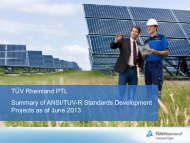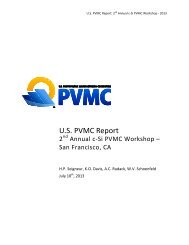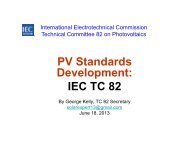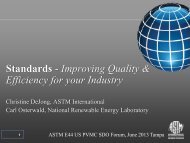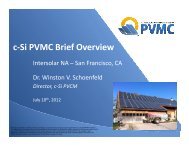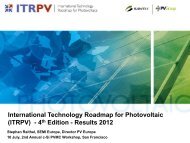You also want an ePaper? Increase the reach of your titles
YUMPU automatically turns print PDFs into web optimized ePapers that Google loves.
U.S. <strong>PVMC</strong> <strong>Report</strong>: 2 nd <strong>Annual</strong> <strong>SDO</strong> <strong>Forum</strong> Summary - 2013<br />
U.S. <strong>PVMC</strong> <strong>Report</strong><br />
2 nd <strong>Annual</strong> <strong>SDO</strong> <strong>Forum</strong> at<br />
IEEE PVSC 2013 – Tampa, FL<br />
H.P. Seigneur, K.O. Davis, A.C. Rudack, M. Rodgers,<br />
W.V. Schoenfeld<br />
June 19 th , 2013
[Type text] [Type text] [Type text]<br />
Table of Contents<br />
Summary .................................................................................................................................................. 4<br />
Participants ............................................................................................................................................. 5<br />
Workshop Agenda 1 ............................................................................................................................... 7<br />
Pre-forum Survey .................................................................................................................................. 8<br />
Open Discussion .................................................................................................................................... 8<br />
1 – Potential Gaps ..................................................................................................................................... 8<br />
2 – Scope/Overlap Among <strong>SDO</strong>s and SAOs ............................................................................................. 15<br />
3 – Communication, Coordination, and Dissemination .......................................................................... 16<br />
Summary and Conclusions ............................................................................................................... 18<br />
Appendix A: Pre-<strong>Forum</strong> Survey Results ...................................................................................... 19<br />
Question 1 ............................................................................................................................................... 19<br />
Question 2 ............................................................................................................................................... 20<br />
Question 3 ............................................................................................................................................... 21<br />
Question 4 ............................................................................................................................................... 22<br />
Questions 5 – 13: Gaps Input .................................................................................................................. 23<br />
Question 14 ............................................................................................................................................. 25<br />
Question 15 ............................................................................................................................................. 27<br />
Questions 16 & 17 ................................................................................................................................... 28<br />
Question 18 ............................................................................................................................................. 29<br />
Question 19 ............................................................................................................................................. 29
U.S. <strong>PVMC</strong> <strong>Report</strong>: 2 nd <strong>Annual</strong> <strong>SDO</strong> <strong>Forum</strong> Summary - 2013<br />
Summary<br />
On June 19 th , 2013 at the IEEE PVSC conference in Tampa, FL the crystalline silicon branch<br />
of the U.S. Photovoltaic Manufacturing Consortium (c-Si <strong>PVMC</strong>) held the 2 nd <strong>Annual</strong> <strong>SDO</strong><br />
<strong>Forum</strong>. The <strong>Forum</strong> was organized through collaboration with the following organizations:<br />
International PV Module QA Task Force<br />
®<br />
The <strong>SDO</strong> <strong>Forum</strong> is intended to be a platform to promote a cohesive and collaborative<br />
approach to PV standards and codes, with the primary goals of:<br />
1. Facilitating increased communication and coordination between the stakeholders<br />
2. Improving the dissemination of standards/codes being developed<br />
3. Supporting the wide adoption of developed standards/codes, and<br />
4. Identifying challenges and gaps in standards/codes in an effort to foster potential<br />
solutions<br />
The <strong>SDO</strong> <strong>Forum</strong> began with short presentations from each <strong>SDO</strong> and SAO, followed by an<br />
Open Discussion Period with three focus topics:<br />
1. Potential Gaps<br />
2. Scope/Overlap among <strong>SDO</strong>s and SAOs<br />
3. Communication, Coordination, and Dissemination<br />
Much of the open discussion was based on results from a pre-forum survey that was<br />
completed by many participants prior to the event.
U.S. <strong>PVMC</strong> <strong>Report</strong>: 2 nd <strong>Annual</strong> <strong>SDO</strong> <strong>Forum</strong> Summary - 2013<br />
Participants<br />
First Name Last Name Email Address Affiliation<br />
David Burns dmburns@mmm.com 3M<br />
Mark Campanelli mark.campanelli@nrel.gov NREL<br />
Philip Capps philip_capps@jabil.com Jabil<br />
Kris Davis Kris.Davis@uspvmc.org <strong>US</strong> <strong>PVMC</strong><br />
Christine DeJong cdejong@astm.org ASTM International<br />
Neelkanth Dhere dhere@fsec.ucf.edu Florida Solar Energy Research Center<br />
Nanditha Dissanayake ndissanayake@bnl.gov Brookhaven National Laboratory<br />
Brian Dougherty brian.dougherty@nist.gov NIST<br />
Chris Eberspacher chriseberspacher@yahoo.com Unknown<br />
Keith Emery Keith.Emery@nrel.gov NREL<br />
Halden Field halden@pvmeasurements.com PV Measurements, Inc.<br />
Christopher Flueckiger Christopher.Flueckiger@ul.com Underwriters Laboratories<br />
Sean Fowler sfowler@q-lab.com Q-Lab Corporation<br />
Charles Hanley cjhanle@sandia.gov Sandia National Laboratories<br />
dan holladay Dan.Holladay@sematech.org SEMATECH<br />
Adam Hough adamh@itwsolar.com ITW Solar<br />
Jim Huggins jhuggins@solar-rating.org Solar Rating & Certification Corporation<br />
Jane Kapur jane.kapur@usa.dupont.com DuPont Photovoltaics-Encapsulants<br />
George Kelly solarexpert13@gmail.com Sunset Technology, Inc.<br />
Eric Kelso ekelso@pvmeasurements.com PV Measurements, Inc.<br />
Michael Kempe michael.kempe@nrel.gov NREL<br />
Tomas Koenig tkoenig@solar-rating.org Solar Rating & Certification Corporation<br />
Pramod Krishnani pramod.krishnani@belectric.com Belectric Inc.<br />
Sarah Kurtz sarah.kurtz@nrel.gov NREL<br />
Sumanth Lokanath slokanath@firstsolar.com First Solar<br />
Scott McWilliams scott.mcwilliams@uspvmc.org <strong>US</strong> <strong>PVMC</strong><br />
Shaun Montminy smontminy@spirecorp.com Spire<br />
Dony Oommen doommen@gaf.com GAF<br />
Carl Osterwald Carl.Osterwald@nrel.gov NREL<br />
Nancy Phillips nancyphillips@mmm.com 3M<br />
Stephen Pisklak spisklak@dow.com Dow Chemical<br />
Siddharth Ram Athreya srathreya@dow.com Dow Chemical<br />
Florian Reil florian.reil@de.tuv.com TUV Rheinland<br />
Andrew C Rudack andy.rudack@uspvmc.org <strong>US</strong> <strong>PVMC</strong><br />
David Sanchez david.sanchez@materion.com Materion Advanced Chemicals<br />
Eric Schneller eschneller@knights.ucf.edu University of Central Florida<br />
Winston Schoenfeld Winston.Schoenfeld@uspvmc.org <strong>US</strong> <strong>PVMC</strong>
U.S. <strong>PVMC</strong> <strong>Report</strong>: 2 nd <strong>Annual</strong> <strong>SDO</strong> <strong>Forum</strong> Summary - 2013<br />
Markus Schweiger markus.schweiger@de.tuv.com TÜV Rheinland<br />
Hubert Seigneur hubert.seigneur@uspvmc.org University of Central Florida<br />
Narendra Shiradkar nshiradkar@fsec.ucf.edu Florida Solar Energy Research Center<br />
Ron Sinton ron@sintoninstruments.com Sinton Instruments<br />
Owen Westbrook owestbrook@juwisolar.com Juwi Solar Inc<br />
Linda Wilson linda.wilson@sematech.org SEMATECH<br />
John Wohlgemuth john.wohlgemuth@nrel.gov NREL<br />
Scott Zimmerman scott.zimmerman@ametek.com Atlas Material Testing Technology LLC
U.S. <strong>PVMC</strong> <strong>Report</strong>: 2 nd <strong>Annual</strong> <strong>SDO</strong> <strong>Forum</strong> Summary - 2013<br />
Workshop Agenda 1<br />
5:00p – 5:20p Registration / Refreshments<br />
5:20p – 5:30p Welcome Comments and <strong>Forum</strong> Overview<br />
Winston Schoenfeld, FSEC / c-Si <strong>US</strong> <strong>PVMC</strong><br />
5:30p – 5:45p SEMI<br />
Kevin Nguyen, SEMI<br />
5:45p – 6:00p ASTM International<br />
Christine DeJong, ASTM / Carl Osterwald, NREL<br />
6:00p – 6:15p IEC<br />
George Kelly, BP<br />
6:15p – 6:30p International PV Module QA Task Force<br />
John Wohlgemuth, NREL<br />
6:30p – 6:45p TUV Rheinland<br />
Mani Govindasamy Tamizhmani, TUV Rheinland<br />
6:45p – 7:00p Coffee Break / Networking<br />
7:00p – 7:15p UL<br />
Chris Flueckiger, UL<br />
7:15p – 7:30p Solar ABCs<br />
John Wohlgemuth, NREL<br />
7:30p – 7:45p CIGS <strong>US</strong> <strong>PVMC</strong><br />
Linda Wilson, SEMATECH / <strong>US</strong> <strong>PVMC</strong><br />
7:45p – 8:30p Open Discussion<br />
Moderator: Winston Schoenfeld, FSEC / c-Si <strong>US</strong> <strong>PVMC</strong><br />
8:30p – 8:40p Summary / Meeting Wrap-Up<br />
8:40p – 9:30p Networking Reception<br />
1To download the 2013 2 nd <strong>Annual</strong> <strong>SDO</strong> <strong>Forum</strong> materials, refer to the following link:<br />
http://www.uspvmc.org/event_archives.html
U.S. <strong>PVMC</strong> <strong>Report</strong>: 2 nd <strong>Annual</strong> <strong>SDO</strong> <strong>Forum</strong> Summary - 2013<br />
Pre-forum Survey<br />
Prior to the <strong>Forum</strong>, a pre-forum survey was generated to gather information for various uses, a<br />
primary one being input to assist in the open discussion section. Just before the event, the results<br />
were compiled and assembled into a slide set that allowed effective reporting of open discussion<br />
relevant results. A summary of the Pre-forum Survey results is provided in Appendix A at the end<br />
of this report. The next section summarizes the open discussion that took place at the event along<br />
with excerpts of the slide deck used to assist in the discussions.<br />
Open Discussion<br />
The following section provides an overview of the open discussion period that covered three<br />
topical areas: (1) Potential Gaps, (2) Scope/Overlap of <strong>SDO</strong>s, and (3) Communication,<br />
Coordination, and Dissemination. To assist in the<br />
1 – Potential Gaps<br />
Those completing the pre-forum survey were asked to list gaps they feel exist in current<br />
standards/codes. Along with a short description, they were also asked to indicate its associated<br />
area (e.g. wafer, cell, module, system integration, etc…) and list up to two <strong>SDO</strong>s that they feel<br />
most suitable to address the listed gap.<br />
The open discussion on potential gaps was organized by area, consistent with the survey. The<br />
moderator, Dr. Winston V. Schoenfeld, read out the list of potential gaps taken from the survey<br />
and then opened the floor for open discussion. Below the slides for each area are provided,<br />
followed by any discussion content that was captured.
U.S. <strong>PVMC</strong> <strong>Report</strong>: 2 nd <strong>Annual</strong> <strong>SDO</strong> <strong>Forum</strong> Summary - 2013<br />
• One attendee stated that standards for CIGS materials and chemicals is something that<br />
should be considered by the PV community considering the challenges of scaling up<br />
manufacturing without standardized process materials<br />
• The first statement in the slide above (“Standards to test against degradation…”) isn’t<br />
really accurate from the perspective of module manufacturers according to one<br />
attendee. However, another attendee stated that while materials suppliers participate<br />
heavily in these types of standard activities, module manufacturers do not to the same<br />
level.<br />
• One attendee noted that the Chinese government, as well as the language barrier and<br />
large time zone difference with the west have limited participation by Chinese<br />
companies and organizations in the International PV Module QA Task Force<br />
• It was noted that the lack of material standards for non-crystalline materials may be the<br />
results of not being sure these material would stick around.<br />
• A general comment was made during this slide about perhaps the need not only for<br />
preemptive but reactionary type of standard development activities referring to Solar<br />
ABCs activity relating to a short notice on changes in the fire rating/code.
U.S. <strong>PVMC</strong> <strong>Report</strong>: 2 nd <strong>Annual</strong> <strong>SDO</strong> <strong>Forum</strong> Summary - 2013<br />
• One attendee raised the point that the probing/contacting of wafers is not standardized<br />
• Another attendee also mentioned that performance/efficiency measurements of wafers<br />
in production are not clear because cells are not finished. There is a need for different<br />
tests for lab and production environments.
U.S. <strong>PVMC</strong> <strong>Report</strong>: 2 nd <strong>Annual</strong> <strong>SDO</strong> <strong>Forum</strong> Summary - 2013<br />
• There was a clarifying statement made in connection with the radiance distribution. The<br />
need is respecting the angular distribution and not spectral distribution which is well<br />
defined already.<br />
• Regarding PID and a standard test, there is a draft with IEC<br />
• There is a draft regarding greater sample size (1853 p1, UL 4730)<br />
• Metastable module is not clearly defined<br />
• A question was asked about the existence of a standard addressing energy rating for<br />
various climates. The answer was yes – there is a draft (1853)
U.S. <strong>PVMC</strong> <strong>Report</strong>: 2 nd <strong>Annual</strong> <strong>SDO</strong> <strong>Forum</strong> Summary - 2013<br />
• One attendee expressed concern over the lack of standards addressing the upcoming<br />
NEC code change (2017 code cycle). A standard must be developed by 2015. Is there a<br />
need to pull NEC and other in future <strong>SDO</strong> forum so that the solar <strong>SDO</strong> do not always<br />
work in a reactionary mode but rather could coordinate early with code organizations<br />
• Another attendee mentioned that UL is currently looking into this issue (1699b)<br />
• On the issue of PV wiring standards (highlighted in the slide above), one attendee<br />
explained that safety standards (UL9703) are not the same thing as predictors of<br />
lifetime (e.g. reliability, durability)<br />
• One attendee stated that standards (e.g. test standards) need data to substantiate<br />
them, so data sharing by the PV community should be encouraged to ensure the best<br />
and most appropriate standards are used<br />
• For connectors and cables – WG10 of TC82 is looking into that.
U.S. <strong>PVMC</strong> <strong>Report</strong>: 2 nd <strong>Annual</strong> <strong>SDO</strong> <strong>Forum</strong> Summary - 2013<br />
• Regarding “PV module loading”, it was mentioned that IEC/UL set limits to 3x that of the<br />
standard code in general. This is a significant challenge since the code for building<br />
changes with geographical location.
U.S. <strong>PVMC</strong> <strong>Report</strong>: 2 nd <strong>Annual</strong> <strong>SDO</strong> <strong>Forum</strong> Summary - 2013<br />
• At this point, one attendee shared a general comment that ASTM standards are much<br />
more detailed in describing test methods when compared to international standards<br />
• Another attendee asked the questions as to why standards don’t show up on search<br />
results for things like Google Scholar (Not full standard, but at least an<br />
abstract/summary), pointing out that better integration with the scientific community<br />
would likely improve the quality of standards
U.S. <strong>PVMC</strong> <strong>Report</strong>: 2 nd <strong>Annual</strong> <strong>SDO</strong> <strong>Forum</strong> Summary - 2013<br />
2 – Scope/Overlap Among <strong>SDO</strong>s and SAOs<br />
• There is an overlap between 61215 and (61730); however, it is a healthy overlap. In<br />
practice, these standards are not redundant; they have different goals. There is a need<br />
to explain what the differences are and thus educate others.
3 – Communication, Coordination, and Dissemination<br />
U.S. <strong>PVMC</strong> <strong>Report</strong>: 2 nd <strong>Annual</strong> <strong>SDO</strong> <strong>Forum</strong> Summary - 2013
U.S. <strong>PVMC</strong> <strong>Report</strong>: 2 nd <strong>Annual</strong> <strong>SDO</strong> <strong>Forum</strong> Summary - 2013
U.S. <strong>PVMC</strong> <strong>Report</strong>: 2 nd <strong>Annual</strong> <strong>SDO</strong> <strong>Forum</strong> Summary - 2013<br />
Conclusion<br />
Overall the 2 nd <strong>Annual</strong> <strong>SDO</strong> <strong>Forum</strong> served as a useful platform for open discussion and better<br />
understanding of the current and future activities of the multiple <strong>SDO</strong>/SAO groups. The preforum<br />
survey was highly valuable in stimulating the open discussion, and when coupled with<br />
the open discussion content led to multiple potential action items that the organizing entities<br />
have an opportunity to utilize collaboratively for mutual benefit. This report is meant to<br />
document the content of the 2 nd <strong>Annual</strong> <strong>SDO</strong> <strong>Forum</strong> and to be used by the organizing groups in<br />
preparation for follow-up meetings to determine specific action items that can be targeted as a<br />
group to capitalize on the multiple opportunities that were identified during the forum.
U.S. <strong>PVMC</strong> <strong>Report</strong>: 2 nd <strong>Annual</strong> <strong>SDO</strong> <strong>Forum</strong> Summary - 2013<br />
Appendix A: Pre-<strong>Forum</strong> Survey Results<br />
Question 1
Question 2<br />
U.S. <strong>PVMC</strong> <strong>Report</strong>: 2 nd <strong>Annual</strong> <strong>SDO</strong> <strong>Forum</strong> Summary - 2013
Question 3<br />
U.S. <strong>PVMC</strong> <strong>Report</strong>: 2 nd <strong>Annual</strong> <strong>SDO</strong> <strong>Forum</strong> Summary - 2013
U.S. <strong>PVMC</strong> <strong>Report</strong>: 2 nd <strong>Annual</strong> <strong>SDO</strong> <strong>Forum</strong> Summary - 2013<br />
Question 4<br />
Responses:<br />
1. Provide materials perspective and needs for innovative thin film and alloy/metal<br />
materials.<br />
2. Usually attendance is limited to ties when the meetings are close or combined with<br />
other events. Can't justify attending just the ASTM meeting at this time/budget<br />
environment.<br />
3. To work on standards.<br />
4. Interested in supporting standards development.<br />
5. IEC, <strong>US</strong>A Member Task Leader Thin Film PV Module Reliability, Co-Task Leader, Hot and<br />
Humid (with Voltage bias) Group, Member, Diodes Group; International PV Module<br />
Module QA Task Force Task Leader Thin Film PV Module Reliability, Co-Task Leader, Hot<br />
and Humid (with Voltage bias) Group, Member, Diodes Group; IEEE Senior Life Member,<br />
Photovoltaics Specialist.<br />
6. Because we use these standards in our daily work.<br />
7. We have developed several PV standards within SEMI. Our interest is to have standards<br />
that are technically sound and commercially neutral. We are industrial members of<br />
<strong>PVMC</strong>, and go to IEEE technical conferences.<br />
8. A) Present, review, discuss technical data relative to standards, and B) Participate in the<br />
development of standards.<br />
9. Voting member in some; Supporting standard NWIP/updates in others<br />
10. Networking and collaborative working sessions to actually work on standards.<br />
11. As a leader or co-chair.<br />
12. To ensure competitors do not gain an advantage due to language in standards; to offer<br />
assistance in my company's areas of expertise in the standards development process.<br />
13. Stay in touch with the industry - promote standards activities.<br />
14. Give suggestions.<br />
15. I have an interest in understanding upcoming proposals and changes to standards as<br />
they can both positively and negatively influence our business and the industry as a<br />
whole.<br />
16. Standards ultimately save money and will lower the cost of solar products.<br />
17. To help connect industry gaps to needs in standards development, adoption, awareness<br />
18. Because I am Vice Chair.<br />
19. To represent the interest of our member companies at the <strong>PVMC</strong>.
U.S. <strong>PVMC</strong> <strong>Report</strong>: 2 nd <strong>Annual</strong> <strong>SDO</strong> <strong>Forum</strong> Summary - 2013<br />
Questions 5 – 13: Gaps Input<br />
Materials/Chemicals<br />
1) Disconnect between material demands and proper inclusion of materials companies to<br />
provide proper materials with proper scale to meet ultimate demand. Fractured solar<br />
efforts obscure business case and make materials production investment difficult.<br />
Suggested <strong>SDO</strong>: Not Sure<br />
2) Standards to test against degradation of module materials due to exposure to sunlight<br />
and moisture is being addressed by IEC and the Int. PV Module QF, but there seems to<br />
be little participation from module manufacturers. Suggested <strong>SDO</strong>: Not Sure<br />
3) Lack of unified/accepted materials standards; Having an accepted/standardized<br />
methodology for measuring all of the parameters that are important to identify<br />
feedstock quality Suggested <strong>SDO</strong>s: SEMI, ASTM<br />
4) Overall Si recycling, incorporating recovered Si back into crystal melt; Utilization and<br />
standardization of kerf fines for incorporation into melt Suggested <strong>SDO</strong>s: SEMI, ASTM<br />
Wafers<br />
1) There is a need for a standard for marking / tracking wafers that does not rely on<br />
patented technology and that is based on a PV industry consensus from wafer<br />
producers, cell manufacturers, module manufacturers, and developers/installers.<br />
Ultimately, all these are stakeholders as there is a need to track wafers from the<br />
feedstock source all the way to field testing in order to improve reliability and durability.<br />
Suggested <strong>SDO</strong>s: SEMI, IEC<br />
2) Unified incoming wafer specifications and standards; Better specifications for<br />
mechanical and electrical characterization (Affects cell efficiency & end product<br />
performance). Consistency is needed. Lack of detailed information from customers (only<br />
pass/fail info given); Lack of <strong>US</strong> based solar companies for partnerships. Suggested<br />
<strong>SDO</strong>s: SEMI, IEC<br />
Cells<br />
1) Defectivity contribution - do we neeed PV focus on particles, surface chemistry,<br />
electrostatic attraction and standards in place Suggested <strong>SDO</strong>: SEMI
U.S. <strong>PVMC</strong> <strong>Report</strong>: 2 nd <strong>Annual</strong> <strong>SDO</strong> <strong>Forum</strong> Summary - 2013<br />
Modules<br />
1) Long-term durability concerns - linking of individual standards organizations. Suggested<br />
<strong>SDO</strong>s: ASTM, IEC<br />
2) There is no specification of the radiance distribution of the of light that illuminates a PV<br />
device in various calibrations and performance measurements. Suggested <strong>SDO</strong>s: ASTM,<br />
IEC<br />
3) Module size. Suggested <strong>SDO</strong>: SEMI<br />
4) PID (Potential Induced Degradation) test needs to be defined. Suggested <strong>SDO</strong>: ASTM<br />
5) Long-term reliability testing of modules for performance as well as safety as part of<br />
module qualification. There is a need for more rigorous testing than module<br />
qualification standards currently require and a need for testing greater sample sizes of<br />
modules. Suggested <strong>SDO</strong>s: IEC, UL<br />
6) Module electrical characteristics. Suggested <strong>SDO</strong>s: SEMI<br />
7) Module is electrical equipment, not PV, and belongs to TC15,TC112. Suggested <strong>SDO</strong>s:<br />
IEC, Int. PV Module QTF<br />
Balance of Systems<br />
1) Little data on out door testing of Connectors and cables. Suggested <strong>SDO</strong>s: IEC, IEEE<br />
2) There is no standard for PV wiring. Individual standards exist for components but non<br />
exist that covers an integrated assembly. UL 9703 is inadequate for environment.<br />
Suggested <strong>SDO</strong>s: IEC, UL<br />
3) Long-term durability concerns - linking of individual standards organizations. Suggested<br />
<strong>SDO</strong>s: ASTM, IEC<br />
System Integration<br />
1) Performance testing (short and long-term) for photovoltaic systems. Suggested <strong>SDO</strong>s:<br />
ASTM, Solar ABCs<br />
2) There is a gap between IEC/UL requirements for PV module loading vs. Building code<br />
requirements for structures. This gap needs to be bridged as IEC limits are 2-5x the<br />
building code requirements. Suggested <strong>SDO</strong>s: IEC, Int. PV Module QATF<br />
3) There is no standard for installation and construction practices of systems. Suggested<br />
<strong>SDO</strong>s: IEC, Solar ABCs
U.S. <strong>PVMC</strong> <strong>Report</strong>: 2 nd <strong>Annual</strong> <strong>SDO</strong> <strong>Forum</strong> Summary - 2013<br />
4) Piping Systems and Utilities. Suggested <strong>SDO</strong>s: SEMI<br />
Other<br />
1) Lack of knowledge/communication/acceptance of existing standards. Suggested <strong>SDO</strong>:<br />
Not Sure<br />
Question 14<br />
1. A central web site would be useful to monitor all standards development activity.<br />
2. Central web site, Central web site, …<br />
3. A central web site is a great idea. An email distribution list would also be helpful.<br />
SolarABCs has an excellent system in place for communicating with stakeholders.<br />
4. Website or blog that captures papers from various <strong>SDO</strong>s (IEEE, SVC, AVS, Intersolar NA,<br />
AIMCAL) which highlights critical approaches who need more cogent focus to make<br />
required materials at critical performance and price requirements to facilitate growth.<br />
5. <strong>Annual</strong> forums and perhaps a central website, both, will be helpful. There are too many<br />
organizations to monitor and participate in for my company, so this is a critical area of<br />
concern for me.<br />
6. <strong>SDO</strong> <strong>Forum</strong>, proposed standards dashboard that is well-maintained.<br />
7. <strong>Annual</strong> <strong>SDO</strong> <strong>Forum</strong>, Central <strong>SDO</strong> <strong>Forum</strong> Website, Standard Dashboard<br />
8. Although my first time in attending, I suspect this <strong>Forum</strong> approach at PVSC is a very<br />
approach.<br />
9. <strong>Annual</strong> <strong>SDO</strong> forum + email notifications of NWIP streams.<br />
10. More events where key groups can meet concurrently.
U.S. <strong>PVMC</strong> <strong>Report</strong>: 2 nd <strong>Annual</strong> <strong>SDO</strong> <strong>Forum</strong> Summary - 2013<br />
11. Open availability of data, publications and discussions.<br />
12. In my somewhat limited experience, the standards organizations are not well integrated<br />
with the technical literature. This isolates them to be for insiders only, with each<br />
organization subject to its own strong culture and history which can be difficult to<br />
penetrate. It would be good to have a technical review of the standards, to indicate<br />
which are technically useful for particular applications, and which are not.<br />
13. Do not know, tried already several things, no effect<br />
14. Press release, website announcement<br />
15. Get the stakeholders participating
Question 15<br />
U.S. <strong>PVMC</strong> <strong>Report</strong>: 2 nd <strong>Annual</strong> <strong>SDO</strong> <strong>Forum</strong> Summary - 2013
U.S. <strong>PVMC</strong> <strong>Report</strong>: 2 nd <strong>Annual</strong> <strong>SDO</strong> <strong>Forum</strong> Summary - 2013<br />
Questions 16 & 17<br />
Responses:<br />
1) All main conferences attempt to include sessions for thin film, thick film and devicessome<br />
better than others. Capturing the fractured efforts may be biggest challenge.<br />
2) ASTM and IEC on many PV equipment related standards.<br />
3) IEC 60904-1 with ASTM E948 and E1036; IEC 60904-7 with ASTM E973; IEC 60904-9 with<br />
ASTM E927; etc..<br />
4) IEC and ASTM on cell and module measurements. IEC and Semi on PV wafer and<br />
electronic wafer characterization.<br />
5) Certain ASTM standards have IEC/UL equivalents. Building code governs structural<br />
design, yet IEC/UL standards have PV loading requirements. IEC developing<br />
transportation standards when ISTA standards already exist.<br />
6) Overlapping UL/IEC standards for PV module testing and certification (e.g. UL 1703 vs<br />
IEC 61215/61646).
U.S. <strong>PVMC</strong> <strong>Report</strong>: 2 nd <strong>Annual</strong> <strong>SDO</strong> <strong>Forum</strong> Summary - 2013<br />
7) Wafer specifications.<br />
8) Actually I am unsure how much overlap exists. There is some coordination between the<br />
PVQA and IEC working groups, for example, and the these two groups have overlapping<br />
members with ASTM. In my opinion, ASTM would be better suited to develop standards<br />
for materials, while IEC should work on system integration and balance of system issues.<br />
PVQA could work with both organizations. I am unfamiliar with the activities of Solar<br />
ABCs and SEMI.<br />
9) IEC 61215/61730 and UL1703<br />
10) IEC/SEMI overlap on cell manufacturing.<br />
Question 18<br />
Question 19



